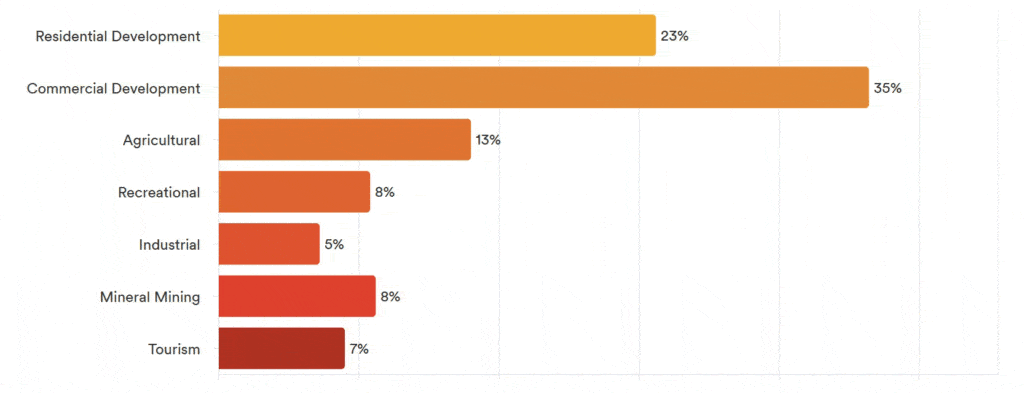Last month, the LANDTHINK Pulse posed the following question to our audience: When investing in land, which of the following uses historically brings the highest return?
In the land real estate market, which kind of properties historically make the most profitable investments? If you’re expecting a simple response, you’re going to be disappointed. There is no one right answer, and the Pulse results from last month was a mixed bag of results. Investing in land can be a highly rewarding venture, but it requires careful consideration of various factors to ensure long-term success. Land, as a finite resource, holds intrinsic value, making it a unique asset for investors. However, selecting the right parcel of land for investment is not a simple task. A lot of different factors will have an effect on the profitability of a land investment, such as location, economic trends, rental demand, environmental factors, and legal constraints.
With patience and strategic thinking, land can serve as a beacon of profit, offering long-term value and variety not as readily found in the stock market. When you buy land, it is yours to use as you see fit. You may choose to develop the land or lease it out to generate income for agricultural, residential, commercial, recreational, or conservation purposes. You may also keep the land for future generations, or simply hold on to it for future appreciation or conservation purposes. This flexibility allows land investors to adapt to changing market conditions and take advantage of emerging opportunities. Overall, the flexibility of land use provides investors with a wide range of options to maximize their returns and minimize risk.

Commercial Development Land is believed to produce the highest rate of return, with 35% of respondents chiming in. Commercial development land is an excellent investment strategy that involves converting raw land into a warehouse, storage facility, factory, mechanic shop, or shopping complex. Investors can also develop raw land into an array of things to generate multiple income streams. When considering land for commercial use, factors such as accessibility, location, and available amenities are crucial for investors to evaluate.
Commercial properties generate high annual rates of return, and can provide substantial tax benefits. Owners can deduct normal expenses, interest on the mortgage, depreciate investments, and defer taxes through the 1031 Exchange. Investing in commercial land real estate can pay off financially, but investors should consult commercial land agents, tax professionals and an attorney in order to get a clear understanding of both the risks and rewards.
Coming in a close second, 23% of the LANDTHINK audience believe that Residential Development Land historically brings the highest returns.
Residential land investment opportunities are a sound approach associated with various advantages. With the high graph of population growth, the demand for homes is constantly in demand in rural areas as well as urban areas. Buying land as an investment in a prime location has the potential of building houses or residential complexes that can significantly give a high appreciation value. Investors often purchase vacant lots with the intention of building single-family homes, multi-unit housing, or planned communities.
Subdivision involves purchasing a large piece of land and then subdividing it to build multiple houses. More parcels of land mean more profit. When you divide the land into smaller pieces, you can sell or lease it to different buyers and keep some for yourself.
Subdividing land requires meticulous planning and adherence to local zoning regulations. Properties closer to urban centers tend to appreciate faster, but rural land offers lower initial costs and long-term development potential. Successful residential land investments depend on market timing, location, and an understanding of local housing demand.
Coming in third, 8% said Agricultural Land historically brings the highest returns. Agricultural investment land refers to land used for farming and other agricultural activities, offering potential financial returns through crop production, livestock grazing, or timber harvesting.
Farmland has historically produced bigger returns than stocks, bonds or mutual funds over the long run. Farmland values have been holding steady, despite downward pressures like trade uncertainties, reduced farm income, and higher interest rates. Most farms don’t come up for sale for several generations, which keeps high-quality farmland in high demand. Technological advancements in farming and sustainable practices can further enhance farmland’s productivity and value.
When you think about agricultural land, you may not immediately think of timber. But timber falls under agricultural land and, along with the land it grows on, is a viable alternative investment with decades of strong historical performance. Investing in timberland is one of the smartest ways to diversify your portfolio while generating income. Practicing proper harvesting and reforestation techniques can ensure that your timberland investment stays profitable indefinitely.
Land investment can be a lucrative way to generate passive income and build wealth over time. Each property type has its pros and cons, and the ROI potential varies for each. It’s crucial to do your due diligence and research the market thoroughly. Additionally, it’s essential to have a solid investment strategy and a long-term outlook. If you’re looking to invest in land but don’t know where to start or what potential pitfalls to look out for, be sure to consult with a land professional who can help guide you through the process. With the right guidance, land investments can be a great way to diversify your portfolio and earn long-term returns.
Do you have a suggestion for next month’s Pulse question? Submit your question and we might choose yours!
This content may not be used or reproduced in any manner whatsoever, in part or in whole, without written permission of LANDTHINK. Use of this content without permission is a violation of federal copyright law. The articles, posts, comments, opinions and information provided by LANDTHINK are for informational and research purposes only and DOES NOT substitute or coincide with the advice of an attorney, accountant, real estate broker or any other licensed real estate professional. LANDTHINK strongly advises visitors and readers to seek their own professional guidance and advice related to buying, investing in or selling real estate.










Add Comment